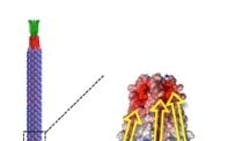Electricity from viruses
What's 880 nm long and generates electricity?
Why, a piezoelectric virus, of course. It turns out that biological materials such as bones, collagen, and peptide nanotubes can generate electricity in response to pressure. Now researchers at the Lawrence Berkeley National Lab say they have found a virus with similar piezoelectric properties.
The virus is called M13 bacteriophage. It only attacks bacteria and is benign to people. It replicates itself by the millions within hours, so there’s no shortage of the stuff. LBNL researchers say it’s easy to genetically engineer. And large numbers of the rod-shaped viruses naturally orient themselves into well-ordered films.
An electrical field applied to a film of M13 viruses cause helical proteins that coat the viruses to twist and turn in response, as a result of the piezoelectric. LBNL scientists increased the virus's piezoelectric strength via genetic engineering to add four negatively charged amino acid residues to one end of the helical proteins that coat the virus. These residues boost the charge difference between the proteins' positive and negative ends, which amplifies the voltage of the virus.
The scientists further enhanced the system by stacking films composed of single layers of the virus on top of each other. They found that a stack about 20 layers thick exhibited the strongest piezoelectric effect. To demonstrate the effect, scientists fabricated a virus-based piezoelectric energy generator. They created the conditions for genetically engineered viruses to spontaneously organize into a multilayered film that measures about one square centimeter. Electrodes on either side of this film connected it to a liquid-crystal display. Pressure on the film, as from a finger tap, produces up to six nanoamperes of current at 400 mV, enough energy to flash the number "1" on the display, at about a quarter the voltage of a triple-A battery.
LBNL researchers are now working on ways to improve the effect. It is relatively easy to go into large-scale production of genetically modified viruses, they say, so piezoelectric materials based on viruses could offer a simple route to novel microelectronics in the future.
The LBNL news release on the virus is here: http://newscenter.lbl.gov/news-releases/2012/05/13/electricity-from-viruses/
The scientists wrote an article about their findings in the online journal Nature Nanotechnology: http://www.nature.com/nnano/journal/vaop/ncurrent/full/nnano.2012.69.html
